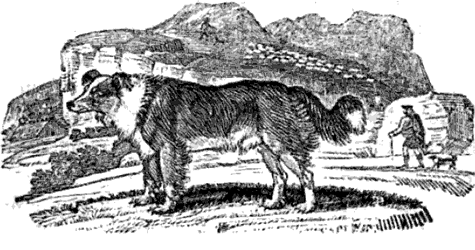
This useful animal, ever faithful to his charge, reigns at the head of the flock; where it is better heard, and more attended to, than even the voice of the shepherd. Safety, order, and discipline, are the fruits of his vigilance and activity.
In those large tracts of land which, in many parts of our island, are solely appropriated to the feeding of Sheep and other cattle, this sagacious animal is of the utmost importance. Immense flocks may be seen continually ranging over those extensive wilds, as far as the eye can reach, seemingly without control: Their only guide is the shepherd, attended by his Dog, the constant companion of his toils: It receives his commands, and is always prompt to execute them ; it is the watchful guardian of the flock, prevents them from straggling, keeps them together, and conducts them from one part of their pasture to another; it will not suffer any strangers to mix with them, but carefully keeps off every intruder. In driving a number of Sheep to any distant part, a well- trained Dog never fails to confine them to the road, watches every avenue that leads from it; where he takes his stand, threatening every delinquent: He pursues the stragglers, if any should escape; and forces them into order, without doing them the least injury. If the herds- man be at any time absent from the flock, he depends upon his Dog to keep them together; and as foon as he gives the well-known signal, this faithful creature conducts them to his master, though at a confiderable distance.
There is a very remarkable singularity in the feet of the Shepherd’s Dog, which we have likewise observed in those of the Cur and the Spaniel. All of them have one, and some two, toes more than most Dogs, though they seem not to be of much use. They appear to be destitute of muscles, and hang dangling at the hind part of the leg more like an unnatural excrescence than a necessary part of the animal. But the adage, that ‘ Nature has made nothing in vain,’ ought to correct our decision on their utility, which probably may exist unknown to us.
This breed of Dogs, at present, appears to be preserved, in the greatest purity, in the northern parts of Scotland; where its aid is highly necessary in managing the numerous herds of Sheep bred in those extensive wilds.

Excerpted from A general history of quadrupeds: The figures engraved on wood By Thomas Bewick, Ralph Beilby – 1807








Be the first to comment